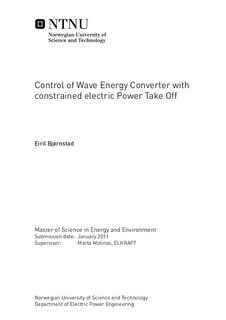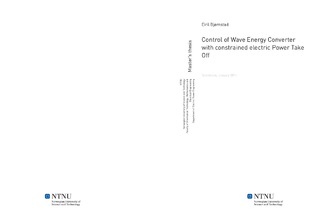| dc.contributor.advisor | Molinas, Marta | nb_NO |
| dc.contributor.author | Bjørnstad, Eiril | nb_NO |
| dc.date.accessioned | 2014-12-19T13:52:31Z | |
| dc.date.available | 2014-12-19T13:52:31Z | |
| dc.date.created | 2011-04-12 | nb_NO |
| dc.date.issued | 2011 | nb_NO |
| dc.identifier | 410155 | nb_NO |
| dc.identifier | ntnudaim:5968 | nb_NO |
| dc.identifier.uri | http://hdl.handle.net/11250/256996 | |
| dc.description.abstract | Because of ocean waves' high energy density and substantial, global technical potential wave energy might become a significant contributor to supply the world's increasing energy demand. The nature of ocean waves is strongly irregular and the power generation from a Wave Energy Converter will have large fluctuations what is a challenge for the electrical system. In the history of wave energy research the focus has been on controlling devices for increasing the absorbed power based on results from mechanical and hydrodynamic mathematical analysis. However, recent work shows that the peak of produced power increases compared to the average absorbed power when traditional control strategies like passive loading and optimal control are applied. The rating and the energy storage requirements of the electrical system will then be increased and the gain due to the increased power production might be lost.In recent work a control strategy that optimizes the torque of the generator with respect to a power saturation level is presented. The work in this report focuses on a practical implementation of this strategy. Further, modifications to meet the torque and speed limitations of the system are made. A control algorithm is presented that utilizes the overrated speed region of the generator to maximize the power production with regards to the power and torque ratings. Simulations for irregular waves and control parameters chosen according to passive loading are then executed and the control algorithm is realized by use of field oriented control of the induction generator. The average absorbed power is changed only to moderate extends compared to the unconstrained case. At the same time the peak to average ratio and the maximum torque is considerably reduced. However, the strategy's reduced torque capability results in a higher maximum speed and pull out speed can be reached. Consequently there will be a trade off between investment costs, produced power and operation range of the system. Therefore the system should be optimized with respect to torque and power limitations, costs, produced power and pullout speed. | nb_NO |
| dc.language | eng | nb_NO |
| dc.publisher | Institutt for elkraftteknikk | nb_NO |
| dc.subject | ntnudaim:5968 | no_NO |
| dc.subject | SIE5 energi og miljø | no_NO |
| dc.subject | Elektrisk energiteknikk | no_NO |
| dc.title | Control of Wave Energy Converter with constrained electric Power Take Off | nb_NO |
| dc.type | Master thesis | nb_NO |
| dc.source.pagenumber | 72 | nb_NO |
| dc.contributor.department | Norges teknisk-naturvitenskapelige universitet, Fakultet for informasjonsteknologi, matematikk og elektroteknikk, Institutt for elkraftteknikk | nb_NO |

